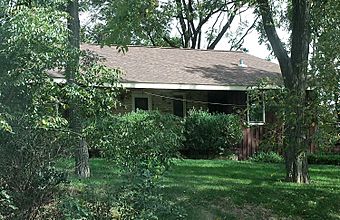Aslak Lie Cabin facts for kids
Quick facts for kids |
|
|
Aslak Lie Cabin
|
|

Aslak Lie Cabin
|
|
| Location | 3022 County Trunk P, Springdale, Wisconsin |
|---|---|
| Area | 5 acres (2.0 ha) |
| Built | 1849 |
| Architect | Aslak Lie |
| NRHP reference No. | 86000622 |
| Added to NRHP | April 3, 1986 |
The Aslak Lie Cabin in Springdale, Wisconsin is a very old and special house. It was built in 1848 by a skilled craftsman named Aslak Lie. He was an immigrant from Norway who brought his traditional building ideas. He also mixed them with newer American ways of building. This unique cabin is so important that it was added to the National Register of Historic Places in 1986.
Contents
The Story of Aslak Lie
Aslak's Early Life in Norway
Aslak Oleson Lie was born in Norway in 1798. His family did not own land and moved often. Aslak learned to read and write, which was not common for everyone back then. He even became a corporal in a military group.
By 1820, Aslak was known as a very skilled craftsman. In 1828, he carved the beautiful wooden part of an organ for a church. He also made furniture. In his home region, he was one of the first to try using thin layers of wood, called veneer. He also experimented with different colored woods in his designs.
In 1826, Aslak married Marit Knudsdatter Dølven. Marit was the daughter of a wealthy landowner. This marriage was a big step up in social standing for Aslak.
Aslak's Norwegian Homes
The same year he got married, Aslak built a small log house. It had three rooms and a large corner fireplace. In 1837, he built another, more modern house on land he owned. This house was L-shaped. Its log walls were covered with vertical boards. It even had a surprising diamond-shaped window! Inside, the rooms were laid out differently from most houses in rural Norway. It also had a sval, which was an outside hallway connecting the rooms.
Moving to America
In 1848, when he was 50 years old, Aslak decided to move from Norway. He traveled with his wife Marit, their six children, and his brother and sister-in-law. In May, they sailed from Bergen, Norway, with many other people from their area. They arrived in New York on June 28.
They traveled on to Wisconsin. They passed Koshkonong, which was a very important Norwegian-American settlement. They finally settled in western Dane County, where only a few Norwegians had moved before.
Building the Wisconsin Cabin
Aslak chose to build his new cabin on a south-facing slope. This spot was above a marsh that fed the Sugar River. The basement of the cabin might have started as a natural dip in the rock. People say that Aslak and his brother lived in a simple dugout home during their first winter. This dugout was likely expanded into the basement by carving out flat areas from the natural rock.
Aslak built the first floor of the cabin in a traditional Norwegian style. He used horizontal logs joined at the corners with special interlocking joints called dovetail joints. He filled the gaps between the logs with wood strips and probably mud or clay. He made the inside walls very smooth, so they didn't need much plaster.
The first floor had two rooms separated by a log wall: a living room and a kitchen. It probably had a wood-burning stove from the start. Aslak put in old-style Norwegian windows that open outwards like doors. He also built a sval (an outside hallway) across the front of the house, just like his second house in Norway. And the diamond shape from his Norwegian house even appeared in the door panels of his Wisconsin home!
The second floor of the cabin looks quite different from the first. It might be that the oak logs in Dane County were harder to work with than the fir and spruce trees in Norway. So, Aslak changed his building method. Instead of logs, the second floor was built with a frame of strong oak timbers. Then, it was covered with boards placed up and down. The windows on the second floor were American-style, meaning they slid up and down. This floor was divided into two rooms: a warm bedroom and a "cold storage room" for food, clothes, and furniture.
Aslak's Community Role
Aslak was more than just a builder; he was a leader in his new community. Over the years, he helped many other immigrants move to the area. He often gave them clothing and food. He built houses and cabinets for many people.
He also wrote for Norwegian-language newspapers in the Midwest. He helped arrange visits from religious leaders and Norwegian-American spokesmen. Aslak also helped start three Lutheran churches in the area, including one in Springdale.
Later Years and Legacy
When Aslak was 80, he and Marit moved to Buffalo County. They went to live with their son Halvor, who had started a Norwegian-American settlement there. Aslak continued to work on carpentry and help with the church for a while. Marit passed away in 1881, and Aslak died in 1886.
Aslak's house in Springdale was lived in until the 1960s. Then, it sat empty for forty years and started to fall apart. In 2002, the owners gave it to the Folklore Village at Dodgeville. The cabin was carefully recorded, taken apart piece by piece, and moved. Now, the cabin is being restored and rebuilt at Folklore Village.
Images for kids



